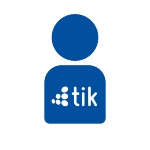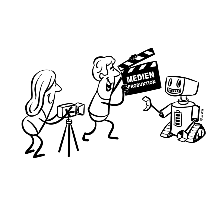Our collaborative workflows as a text description
We start with a kickoff meeting where we sit down with media didactics and subject matter experts. Together, we set the guidelines for the video, including target audience, student engagement, prior knowledge of the target group, and learning objectives.
The subject matter experts then create a rough concept in close collaboration with media production and media didactics. This iterative process allows us to refine all aspects of the video until everyone is satisfied.
The subject matter experts work on the script, which again goes into the feedback loop with media production and media didactics. Before the meetings, we review the script, consider what could be improved, and discuss it in a joint meeting. Depending on the script, this process lasts between 2-3 weeks and 2-3 months. This joint consultation ensures a well-founded and effective script.
Media production takes over the storyboarding and creates an animatic, both of which are optimized in the feedback loop. Although it's just the animatic at this stage, several hours of work have already gone into it. In several iterations, the animatic is continuously adjusted and perfected. At this point, the first evaluation takes place to make adjustments before finalizing the video.
- After joint meetings and adjustments, the final video is produced and subjected to a last feedback loop before it is published.
- Depending on the length and effort, the final video in After Effects can have about 300 layers that all need to be individually animated in transparency, position, rotation, scaling, shape, length, and much more.
- We often also need to include specific illustrations in the video, which must be painstakingly sourced because the videos are published under the CC BY license, limiting us to sources of sometimes poor quality.
- In some videos, there are moving cartoon characters whose appearance must first be created, and for which individual hand movements, body movements, mouth movements, and eye directions must be animated.
- If we need real footage, we are at least three people on set for 2 days for preparations and recordings. The footage must be viewed and sorted, color grading and the first cut made. This process takes several weeks. The result is discussed in the media production team and is improved in several feedback loops.
- Moreover, the sound has to be created. Firstly, the voice-over is recorded in the TIK studio. It's important to us that the sound is clean. So, after setting up the studio, we spend 2 - 4 hours recording the text, depending on the length of the video. Most sentences have 3 - 4 different takes so that we have alternatives for post-production. After everything is properly edited, the mixdown begins. Here, disturbing frequencies are removed first, and the voice is adjusted in its frequencies and dynamics so that the listener has a full and understandable sound. An important part is de-essing, where sibilant sounds are removed. This process takes 2 - 4 days, depending on the length of the video.
- Then, sounds that support what is seen acoustically are added. Some of these sounds are downloaded online, others are produced ourselves. An example would be the sound of a pencil writing on paper while exactly that happens in the video. If the sounds are produced ourselves, the process consists of recording the sound and then editing and adjusting it to the video. The entire process of sounds takes 2 - 4 days. It depends on the duration of the video, the number of sounds themselves, and the number of sounds produced ourselves.
- In addition, music is used for the videos. Due to the CC BY license, we only have limited sources available. Therefore, finding suitable music can take several hours. Sometimes we also produce the music ourselves, such as for our intro and outro. This process consists of composition, recording, arrangement, editing, mixdown, and mastering and can take 3 - 7 days.
Important components of the production process
- A creative and collaborative environment to produce high-quality videos.
- Feedback loops to ensure that the videos meet the educational goals.
- Opportunities for adjustment during production to ensure the video's effectiveness.
Transfer of expertise and procedures, SDG-Campus
The expertise acquired and the established processes were used for the high-quality production of videos for the SDG Campus. The SDG Campus learning platform, in which the University of Stuttgart is involved as a partner university, offers educational programmes on interdisciplinary skills for achieving the 17 UN Sustainable Development Goals (SDGs).
Frequently Asked Questions (FAQ)
- Working title
- Project manager
- Length of the video
- Target audience
- Addressing the audience (informal or formal)
- Prior knowledge of the target group (and assumed technical terms)
- Learning objective
- Understanding problems/tripping points of the target group
- Why is the video necessary?
- Application, everyday relevance, or exam relevance
- First wishes, ideas, and conceptions regarding
There are feedback loops after every step, both during the development of the preliminary concept and during the video production, to ensure that all parties involved are satisfied.
The animatic serves as a middle ground between an animated storyboard and a final, fully developed video. In the animatic, the text is spoken, but not yet professionally recorded and edited. Real shots are quickly and simply filmed or represented in the form of drawn characters. Animation sequences are deliberately kept simple. This approach allows us not to invest too much work if changes arise during the evaluation and, on the other hand, to give students an idea of what the final video will look like. This way, they can properly assess and understand the video without too much time having been invested in a complex production.
Contact

Anna Tobias
B.ENG.Project team member digit@L
Marina Zharova
project employee digit@L, media production





